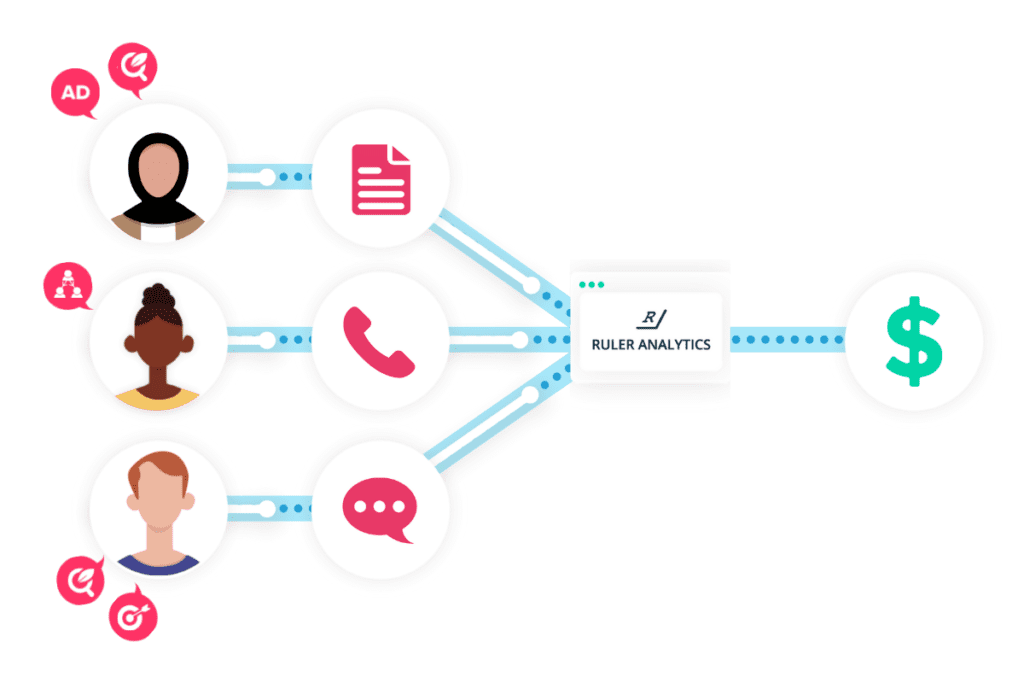Looking for tips for your PPC lead generation strategy? Read our full guide to PPC lead gen and learn how to take your online advertising to the next level.
Pay per click advertising is often relied upon to drive masses of traffic to your website in the hope that something will stick.
But, creating an impactful PPC lead generation campaign takes time, money and data. Even with the most optimised campaigns, you’re not going to see the true impact without the right data tools in place.
So, we decided to step in. Keep reading to learn:
Let’s get stuck in.
You know what lead generation is right?
It’s the method of creating leads ready for your sales team to nurture into sales. Lead generation as a whole can be achieved with any or a mix of marketing channels.
Related: 22 Tips for B2B lead generation: advice from experts
PPC lead generation is the art of creating leads through pay-per-click advertising.
With ad placement available on search engines like Google, Bing and Yahoo, you can create highly targeted adverts and use these to drive traffic that converts.
This guide will run you through everything you need to know to master the art of PPC lead generation. So, if you’re testing the waters or you’re a seasoned advertiser, keep reading to learn how it can impact your bottom line.
Lead generation can occur in a manner of ways. Users might:
Each of these conversion types works very differently. And each business will have its own preference.
For example, a law firm will likely ensure potential clients can contact them via phone call and also use forms on their site to drive leads. Meanwhile, a SaaS company might opt for forms and a live chat tool.
💡 Pro Tip
But the issue isn’t what tools you use to convert leads. What you need to be mindful of is tracking these new leads. Ruler Analytics allows you to track each and every lead plus each and every touchpoint.
Learn how Ruler attributes your revenue to your marketing.
The first step to efficient lead tracking is being able to track the volume of your leads.
That’s simply how many leads are created each month.
Related: Track where your leads are coming from with Ruler
This is fairly easy to do.
With forms, you can track the number of submissions directly on your site. And, if you have a CRM, you can count inbound leads across forms and calls quite easily.
For live chat, you’ll be able to use your native tool to track inbound conversations.
This might take some filtering to weed out customer service chats etc. But lead volume is just the first step. On its own, it means very little.

📈 Pro Tip
Remember, we’re experts in lead tracking, no matter the conversion type.
Learn how to:
– Track form submissions
– Link inbound calls to Google Analytics
– Track live chat conversions and conversations
Imagine you set a new pay-per-click campaign live. You notice your lead volume goes up from 50 to 100.
But, you can’t definitively prove what number of leads came from where. Perhaps your paid ad is supporting growth elsewhere. Or perhaps other initiatives are working to drive you new leads.

This is where attribution comes in.
With attribution software, you can link your inbound leads to your marketing. So, you can definitively prove how many leads each marketing channel, campaign and ad has driven within a set period of time.
💡 Pro Tip
Ruler is the best marketing attribution tool to use when it comes to connecting your inbound leads and sales back to your marketing. Learn how Ruler can help you with its three core functions.
Tracking lead quality isn’t quite as easy as tracking the volume.
And it’s easy to understand why.
Your data is in siloes.
Look at it like this. You generate 100 leads in one month. Even if you can attribute those leads back to the influencing marketing channels, campaigns and ads, you can’t see how these leads progressed.
For example, perhaps only 20 of those 100 leads closed into a sale. If you can’t track the full lifecycle of those leads, you’ll always struggle to understand what’s truly working.
💡 Pro Tip
Ruler doesn’t just track leads, it also tracks revenue. So, when new leads come through you can track them through the full customer journey. When leads close into revenue, you can attribute it back to the marketing channels and campaigns that influenced it.
Lead generation from PPC is a valuable strategy for a number of reasons.
We generally sum them up as the below:
PPC is a great way to be found by your target audience. You can get really targeted on your keyword selection and target audience to ensure you’re appearing in the right searches.
You can create ads around your brand name to ensure you’re top; compete on your product type keywords or even get smart around more topical keywords. All of these will help drive relevant traffic to your site. And, if your site is working well, you’ll be able to drive value through lead generation.
📈 Pro Tip
Did you know that you can see how your keywords work to drive leads and revenue too? Read our definitive guide to PPC conversion tracking
If you’ve done your PPC campaigns well, then you’ll be generating new leads for your business.
That means more leads in your CRM for sales to nurture into sales. While PPC can be costly, it’s often worth it in the long run.
Related: How Ruler affects your paid advertising strategy
Some keywords are highly competitive for organic search. And sometimes, you might not have the domain rating to compete. That usually results in significantly less visibility for you and your business because you’re not being found where you need to be found.
Related: Feature highlight – organic keyword conversion tracking
This is where PPC comes in.
Using paid media allows you to bypass the fight for position 1. Since ads are placed above organic search results, you can get your brand front of mind. Just make sure your ad is click-worthy!

PPC can be used differently throughout the customer journey. For example, many people use PPC as part of their awareness campaigns.
Since PPC is a great way to build awareness around a topic or niche, marketers use it to start customer journeys.
But PPC can also be used in the other stages too. If you’ve got a great offer on a product, you could use that to create a strong remarketing campaign. Retargeting those who’ve previously engaged with you, but not yet converted, is often a quick win.
So, being smart with your paid campaigns is key.
Related: Guide to customer journey stages and how to track them
If you work in eCommerce, then you can definitively prove your return on ad spend (ROAS). But for PPC lead generation, it’s a little trickier. With users engaging via conversion types like phone call, live chat, form or even instore there’s a lot of data at play.
And, remember, users might not convert right away. Proving your PPC ads are starting customer journeys without revenue data and attribution modelling is difficult.
⚡️ Pro Tip
Ruler Analytics allows you to track each and every conversion and prove the impact of your PPC across a full customer journey. Read how we can attribute your closed revenue to your marketing.
Want to create winning PPC campaigns that drive you more revenue and sales? Here are some best practices to stick to when it comes to creating your PPC lead generation campaigns.
Our favourite ways to develop your PPC lead generation is:
Get into the mind of your target audience and think about what they might be searching for when they’re looking for your product or service. Make a note of all of these possible keywords and phrases and run them through a keyword planner tool.
You’ll be able to see which ones are more expensive and projected traffic.
Remember, with Ruler you can see which keywords drive the most traffic, leads and revenue. So, you’ll be able to project revenue based on your most profitable keywords.
Your copy is a vital part of your PPC advert. Pre-qualify your audience within your copy to ensure you’re only getting the right people clicking through.
Related: Top tips for improving your PPC lead quality
Make sure your CTAs stand out and entice the reader to click through.
While you want as much traffic onto your site as possible, they also need to be the right person who is going to click and convert.
When setting up your PPC campaign, take a fresh look at the landing page you’re driving users to.
Does it have clear calls to action and ways for users to convert? Is the copy what they’ll be looking for?
Make sure your ad ties into your landing page and that it’s relevant and useful.
Without a strong landing page in place, users won’t convert. That’s not going to make for a successful lead generation campaign!
Ok, ok, it’s not all about marketing attribution. Except it kind of is. Especially when it comes to lead generation and PPC campaigns.
Remember, Ruler is the must-have tool for when it comes to accurately attributing your closed revenue back to your paid campaigns.
By monitoring your performance on paid, you can quickly identify which ads and keywords are working best to drive your revenue. That allows you to make quick decisions on where to invest more budget and where to pull back.
What you’re left with is a greater return on ad spend and higher visibility of your impact.

Related: How Ruler supports paid marketers and marketing
So, now you know more about PPC lead generation and where to concentrate your efforts. But remember, data is your best friend when it comes to PPC. Without it, you’re likely going to waste huge amounts of budget on ads that only generate high traffic or high numbers of leads.
What we want is a decent amount of high-quality leads that will convert into sales.
Achieving that is made easy when using a marketing attribution tool like ours.
If you’re still not sure how Ruler can support you track every touchpoint, then download our free eBook. It will walk you through how you can track every lead and every touchpoint from the awareness stage to the decision stage. Or, if you’re ready to see the data in action, then book a demo with our team.